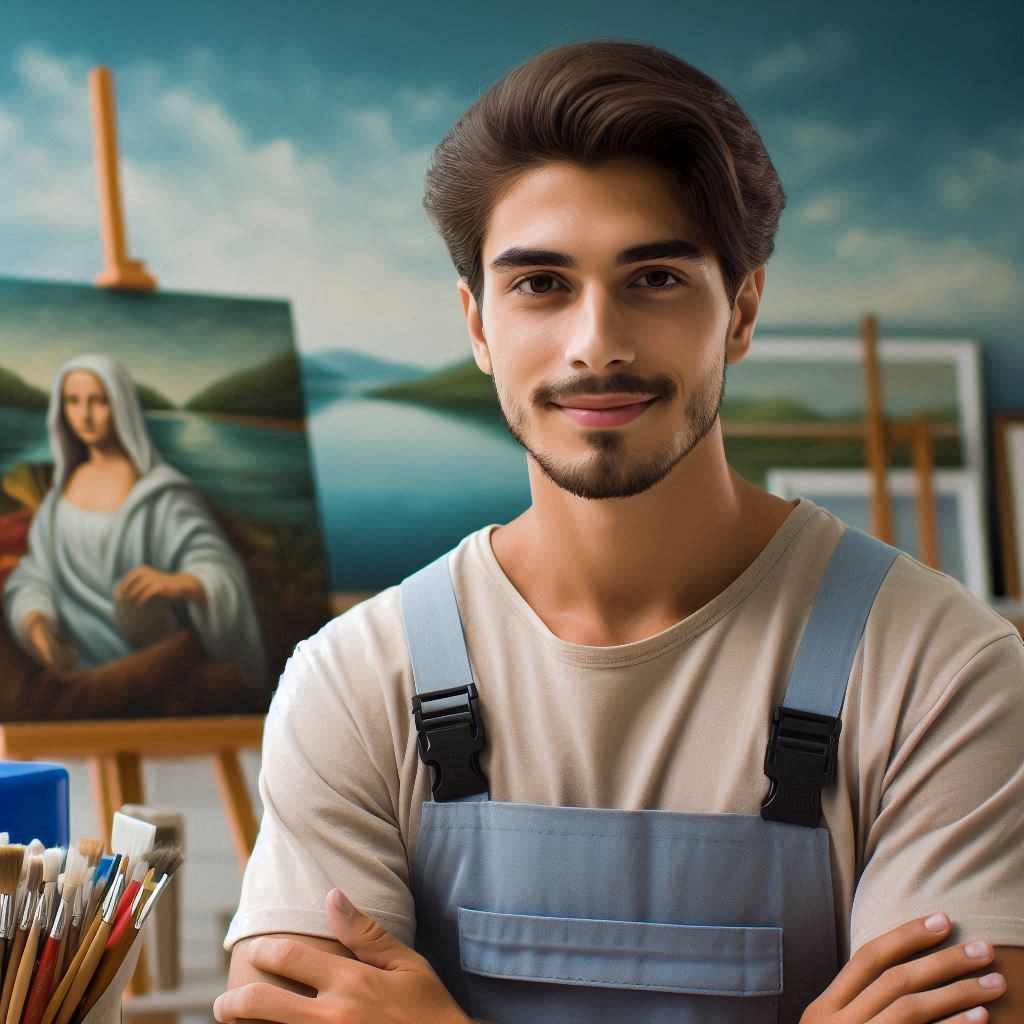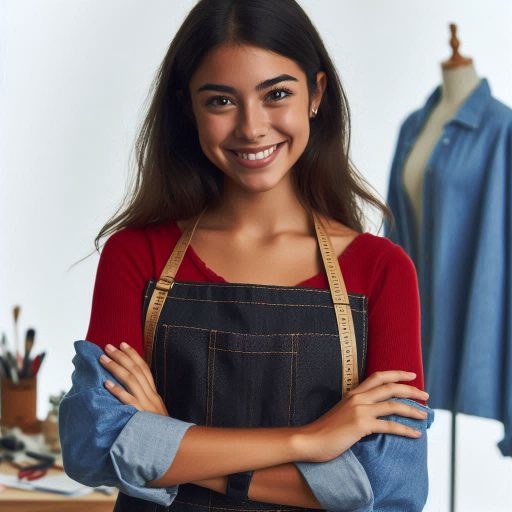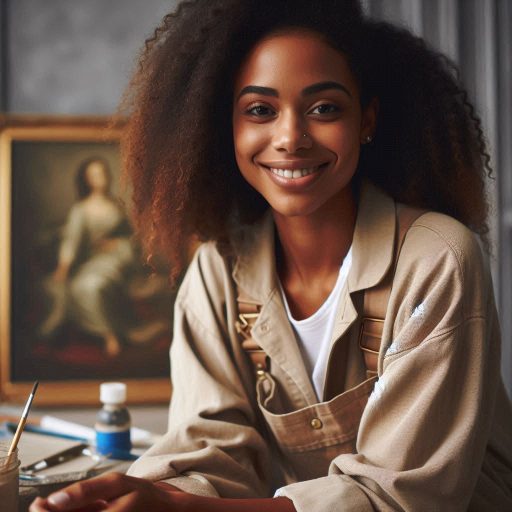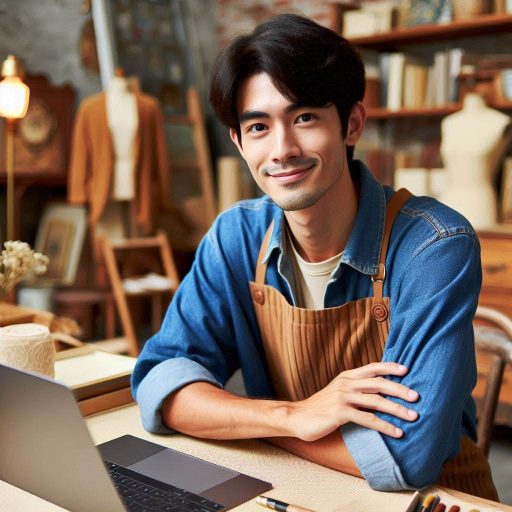Introduction
The art and design industry thrives on creativity and innovation.
It encompasses various fields, including visual arts, graphic design, fashion, and interior design.
As technology evolves, so do the methods and aesthetics in these areas.
Emerging trends often redefine industry standards and influence the broader cultural landscape.
Staying updated with current trends is crucial for professionals in this field.
Trends often drive the market and influence consumer preferences.
Understanding these trends allows artists and designers to remain relevant and competitive.
It helps them anticipate shifts in the industry and adapt their strategies accordingly.
Embracing new trends can also lead to innovative designs and unique creative solutions.
In 2024, several key trends are shaping the art and design landscape.
These include the integration of artificial intelligence in creative processes, a surge in eco-friendly and sustainable practices, and a growing emphasis on digital art forms.
Additionally, the rise of virtual reality (VR) and augmented reality (AR) is transforming how audiences interact with art and design.
This post will explore these trends in detail, offering insights into how they are influencing the industry and what to expect moving forward.
By staying informed about these trends, professionals can harness emerging opportunities and enhance their work.
The dynamic nature of the art and design industry means that innovation is constant.
Understanding and leveraging these trends can lead to exciting new directions and successful career advancements.
Sustainability in Design
Eco-Friendly Materials and Practices
As we look towards the future of the art and design industry, one of the top trends that will continue to gain momentum is the emphasis on eco-friendly materials and practices.
Designers and artists are increasingly aware of the impact their work can have on the environment, and as a result, are seeking out sustainable alternatives.
With advancements in technology, we now have access to a wide range of environmentally friendly materials that can be used in various art and design projects.
From recycled plastics to sustainable wood, the options are endless for those looking to create in a more sustainable way.
Transform Your Career Today
Unlock a personalized career strategy that drives real results. Get tailored advice and a roadmap designed just for you.
Start NowNot only are designers using eco-friendly materials, but they are also incorporating sustainable practices into their work.
This includes things like reducing waste during the production process, using energy-efficient lighting in installations, and sourcing materials locally to reduce their carbon footprint.
Rise of Sustainable Architecture and Interior Design
In addition to the use of eco-friendly materials, we are also seeing a rise in sustainable architecture and interior design.
Designers and architects are incorporating elements like green roofs, solar panels, and passive design principles into their work to create spaces that are both aesthetically pleasing and environmentally friendly.
One of the driving forces behind this trend is the increasing concern for climate change and the need to reduce our carbon footprint.
Consumers are becoming more conscious of the impact their homes and buildings have on the environment, and are therefore seeking out designs that prioritize sustainability.
This shift towards sustainable architecture and interior design is not only beneficial for the environment, but also for the health and well-being of those who inhabit these spaces.
By using natural materials and maximizing natural light, designers are able to create spaces that are not only beautiful, but also promote a sense of health and wellness.
Consumers’ Increasing Demand for Environmentally Conscious Products
Finally, one of the driving forces behind the push towards sustainability in the art and design industry is the increasing demand from consumers for environmentally conscious products.
As people become more aware of the impact their purchasing decisions can have on the environment, they are seeking out products that are made with sustainable materials and practices.
This shift in consumer behavior is prompting designers and artists to rethink their approach to creating and selling their work.
Those who prioritize sustainability in their practice are likely to see an increase in demand for their products, as consumers are willing to pay a premium for items that align with their values.
In fact, sustainability in design is a trend that is here to stay in the art and design industry.
From the use of eco-friendly materials to the rise of sustainable architecture and interior design, it is clear that designers and artists are increasingly prioritizing the planet in their work.
As consumers continue to demand environmentally conscious products, we can expect to see even more innovation in this space in the years to come.
Read: Salary Expectations for Art Conservators/Restorers
Virtual Reality and Augmented Reality
Integration of VR and AR in Art Installations and Galleries
Virtual Reality (VR) and Augmented Reality (AR) are transforming art installations and galleries.
Artists now use VR to create immersive environments that viewers can explore.
With AR, artworks come alive through smartphones or tablets, adding layers of interaction.
Museums and galleries are integrating these technologies to offer new dimensions of art experiences.
Visitors can now walk through a VR painting or see an AR sculpture pop out of the frame.
These technologies enable dynamic and engaging ways to experience art.
Enhancing the Viewer’s Experience Through Immersive Technology
VR and AR enhance viewer experiences by making art more interactive and engaging.
With VR, users can step inside 3D art worlds, feeling as though they are part of the artwork.
AR enriches traditional art forms by overlaying digital elements that react to the viewer’s movements.
This immersion helps viewers connect more deeply with the art.
Interactive elements like virtual tours and augmented visual effects make art accessible in new ways, appealing to tech-savvy audiences.
Immersive technology creates memorable and personalized art experiences.
Collaboration Between Artists and Tech Companies
Collaboration between artists and tech companies is driving innovation in the art world.
Artists partner with tech experts to develop cutting-edge VR and AR experiences.
Tech companies provide the tools and expertise needed to bring artistic visions to life.
These partnerships lead to the creation of novel art forms and interactive installations.
By working together, artists and tech companies push the boundaries of what art can be.
Such collaborations result in groundbreaking projects that redefine the future of art and design.
Read: Freelance vs. In-House Fashion Stylist: Pros and Cons
Inclusivity and Diversity
Push for representation of marginalized communities in art and design
Inclusivity and diversity are reshaping the art and design industry in 2024.
The push for representation of marginalized communities is stronger than ever.
Artists and designers are increasingly recognized for their unique perspectives and contributions.
Institutions and galleries are prioritizing diverse voices to ensure broader representation.
This shift aims to create a more equitable landscape where everyone’s story is told.
Celebrating diversity through artwork and design projects
Celebrating diversity through artwork and design projects has become a significant trend.
Artists are using their platforms to highlight cultural narratives and experiences.
Design projects now feature elements that honor various traditions and histories.
This approach fosters a richer dialogue and enhances understanding among diverse audiences.
It also promotes cultural appreciation and challenges stereotypes.
Increased support for artists from underrepresented backgrounds
Increased support for artists from underrepresented backgrounds is another key trend.
Organizations and funding bodies are actively seeking to amplify these voices.
Grants, residencies, and exhibitions are more accessible to artists who historically faced barriers.
This support helps to level the playing field and encourages a more diverse creative community.
By investing in these artists, the industry can drive innovation and fresh perspectives.
Basically, the commitment to inclusivity and diversity is transforming the art and design industry.
Embracing varied viewpoints and experiences enriches the creative landscape.
As we move forward, these trends will continue to shape a more inclusive and dynamic field.
Read: Art Conservator vs. Art Restorer: Key Differences

Minimalism and Simplicity
Shift Towards Clean, Minimalist Aesthetics in Design
In 2024, the art and design industry increasingly embraces minimalism.
Designers prioritize clean lines, uncluttered spaces, and understated elegance.
This trend reflects a broader desire for simplicity in a complex world.
Minimalist designs emphasize quality over quantity.
The focus shifts from ornate decorations to subtle, impactful elements.
This aesthetic is not only visually pleasing but also creates a sense of calm.
In both digital and physical spaces, minimalism enhances usability and clarity.
This trend signals a move towards thoughtful, intentional design choices that prioritize the essentials.
Focus on Functionality and Simplicity in Art and Product Design
Simplicity in art and product design means prioritizing functionality without sacrificing aesthetics.
Designers are stripping away non-essential elements to enhance user experience.
This approach ensures that each design element serves a purpose.
Functional simplicity in products leads to intuitive use and greater satisfaction.
Artworks are also moving towards clean, straightforward compositions that convey powerful messages with minimalistic approaches.
By focusing on essential functions and removing distractions, designers create more effective and engaging experiences.
This trend highlights a growing appreciation for the integration of form and function.
Influence of Japanese Minimalism on Western Design Trends
Japanese minimalism profoundly influences Western design trends.
The Japanese aesthetic values simplicity, subtlety, and the art of empty spaces.
Western designers adopt these principles, incorporating them into contemporary design practices.
This influence is evident in the rise of serene, uncluttered interiors and products that celebrate understated elegance.
Japanese minimalism teaches that less can indeed be more.
It encourages a shift from excess to thoughtful, purposeful design.
This cross-cultural exchange enriches Western aesthetics, blending Eastern philosophies with modern design sensibilities.
The result is a global design landscape that values simplicity and clarity.
Minimalism and simplicity continue to shape the art and design industry in 2024.
These trends reflect a broader cultural movement towards less clutter and more meaningful design.
Read: Famous American Fashion Stylists and Their Stories
Artisanal Craftsmanship
Revival of Traditional Craftsmanship in Contemporary Art and Design
In 2024, traditional craftsmanship is experiencing a significant revival.
Contemporary artists and designers are embracing time-honored techniques, blending them with modern aesthetics.
This fusion creates unique, innovative pieces that honor past practices while appealing to today’s market.
The resurgence highlights the value of manual skill and historical methods in a digital age.
By integrating traditional craftsmanship, artists preserve cultural heritage and offer fresh perspectives in their work.
Appreciation for Handcrafted, One-of-a-Kind Pieces
The appreciation for handcrafted, one-of-a-kind pieces is growing rapidly.
Consumers increasingly value the uniqueness and authenticity that handcrafted items provide.
Unlike mass-produced goods, these pieces showcase the maker’s individual touch and creativity.
Each item tells a story, enhancing its appeal and significance.
This shift towards valuing distinct, artisanal products reflects a broader desire for personalized, meaningful possessions.
Handcrafted works stand out in a world saturated with uniformity and mass production.
Support for Local Artisans and Small Businesses
Support for local artisans and small businesses is gaining momentum.
Consumers are more conscious of where their products come from and who makes them.
Supporting local artisans fosters community growth and economic stability.
It also ensures that traditional techniques and craftsmanship are preserved and passed down through generations.
Small businesses often offer unique, high-quality items that reflect local culture and creativity.
By choosing artisanal products, consumers contribute to a more sustainable and equitable marketplace.
In summary, artisanal craftsmanship is making a strong comeback in 2024.
Traditional methods blend seamlessly with contemporary design, highlighting the value of handcrafted pieces.
Consumers’ growing appreciation for unique items and support for local artisans underscores a shift towards valuing authenticity and craftsmanship in art and design.
Abstract and Surrealism
The art and design industry in 2024 showcases a growing fascination with abstract art and surrealism.
These styles have surged in popularity, becoming mainstream favorites.
Artists and designers are increasingly drawing inspiration from these genres, which offer fresh perspectives and unique visual experiences.
Growing Popularity of Abstract Art and Surrealism in the Mainstream
Abstract art and surrealism are no longer confined to niche galleries.
They now dominate popular culture and commercial design.
This trend reflects a broader acceptance and appreciation for art that challenges traditional aesthetics.
Modern galleries and online platforms showcase these styles, making them accessible to a wider audience.
Exploration of Emotions and Subconscious Through Art
Abstract and surrealist art delve deep into the human psyche.
Artists use these styles to explore emotions and the subconscious mind.
Abstract art often focuses on colors and forms, while surrealism blends dream-like imagery with reality.
This exploration offers viewers a chance to engage with art on a personal, emotional level.
Influence of Surrealism on Fashion and Graphic Design Trends
Surrealism’s impact extends beyond the canvas, influencing fashion and graphic design.
Designers incorporate surreal motifs into clothing and accessories, creating bold and imaginative pieces.
Graphic design also embraces surreal elements, using them to create eye-catching visuals and innovative branding.
This cross-disciplinary influence highlights surrealism’s versatility and enduring appeal.
All in all, the rise of abstract art and surrealism in 2024 underscores their significant role in shaping contemporary culture.
These styles not only enhance our visual experiences but also push boundaries in art, fashion, and design.
As they continue to evolve, their influence will likely expand, inspiring new trends and creative innovations.
Biophilic Design
Incorporation of Nature and Natural Elements into Design
Biophilic design integrates nature into built environments.
This approach uses natural materials like wood and stone.
It also incorporates plants, water features, and natural light.
The goal is to create a sense of connection with the outdoors.
Designers use large windows and green walls to bring nature inside.
Natural textures and colors are employed to mimic outdoor environments.
This design trend enhances the aesthetic and functional quality of spaces.
By including natural elements, designs become more engaging and refreshing.
Designing Spaces That Promote Health and Wellbeing Through Nature
Spaces designed with biophilic principles support physical and mental health.
Natural elements help reduce stress and increase relaxation.
Incorporating greenery and natural light improves air quality and mood.
These designs create environments that boost productivity and overall wellbeing.
Features like indoor gardens and water streams enhance the sensory experience.
Designs that allow for natural ventilation and daylight contribute to a healthier atmosphere.
By focusing on natural elements, spaces become sanctuaries for rejuvenation and comfort.
Increased Focus on Biophilic Principles in Architecture and Interior Design
Architects and interior designers are increasingly embracing biophilic design.
This trend reflects a growing awareness of its benefits.
Projects now frequently feature biophilic elements, from office buildings to residential spaces.
Integrating biophilic principles helps meet sustainability goals and improve user satisfaction.
Designers are innovating with new ways to incorporate nature into various settings.
This focus also aligns with a broader trend towards eco-friendly and wellness-oriented design.
As biophilic design becomes more prevalent, it reshapes how we experience and interact with our environments.
Conclusion
2024 has introduced several transformative trends in the art and design industry.
From the rise of immersive experiences to the integration of AI tools, this year highlights exciting changes.
Eco-friendly practices and digital art forms are reshaping how we view creativity and sustainability.
Artists and designers should seize this moment to embrace these innovations.
Immersive art, including VR and AR, is revolutionizing how audiences interact with creative works.
By integrating AI into design processes, creators can unlock new possibilities for originality and efficiency.
Adaptability is crucial in this fast-evolving field.
The industry’s rapid technological advancements demand flexibility and openness to change.
Staying updated with trends ensures relevance and continued growth in your creative practice.
Embracing new techniques and tools will keep your work fresh and engaging.
Creativity remains at the core of successful artistry and design.
As trends shift, maintaining a creative edge will help you stand out.
Experiment with emerging technologies and innovative methods to push boundaries and explore new artistic horizons.
In the end, 2024 presents a vibrant landscape for art and design.
By embracing innovation and adapting to changes, artists and designers can thrive in this dynamic environment.
Your ability to blend creativity with new trends will drive success and keep your work impactful.




